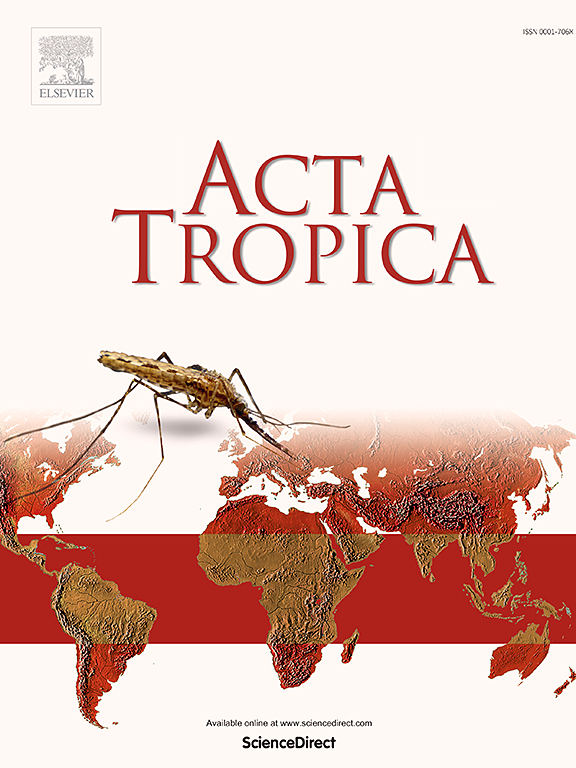Epidemiological and molecular typing of dengue viruses circulating in Jorhat district, Assam, India
IF 2.1
3区 医学
Q2 PARASITOLOGY
引用次数: 0
Abstract
Background
Dengue is a significant mosquito-borne infection that causes public health concern, particularly in tropical and subtropical regions. This study aimed to characterize the molecular typing of dengue viruses in Jorhat district, as information on dengue serotypes is scarce in India.
Methods
A total of 1359 serum samples of clinically suspected dengue cases were tested for non-structural protein 1 (NS1) antigen and Immunoglobulin M (IgM) antibody using enzyme-linked immunosorbent assay (ELISA). Additionally, viral RNA was extracted from positive samples for multiplex reverse transcriptase-polymerase chain reaction (RT-PCR) to determine the dengue serotypes. Seasonal variations, gender, and age-wise incidences were also studied. Statistical analysis was performed to assess demographic and clinical characteristics.
Results
This study depicts a substantial burden of dengue, with 370 (27.22 %) positive samples. IgM and NS1 ELISA tested positive for 42 (11.3 %) and 328 (88.6 %) samples. Dengue virus (DENV) cases predominantly affected males (58.4 %) and the age group of 16–30 years. The major clinical manifestations include fever, headache, and body aches. Serotyping revealed DENV-2 as the predominant serotype, followed by DENV-3 and DENV-1. The co-infection of DENV-2 and DENV-3 was observed in many cases. Seasonal clustering of dengue cases indicates the highest peak in September and October.
Conclusions
This study provides valuable insights into the epidemiology, diagnosis, and serotyping of dengue viruses in the Jorhat district of Assam, emphasizing the need for continued surveillance and effective vector control measures that should be implemented to mitigate the early detection of dengue in this region.
印度阿萨姆邦Jorhat地区流行的登革热病毒的流行病学和分子分型。
背景:登革热是一种重要的蚊媒感染,引起公共卫生关注,特别是在热带和亚热带地区。这项研究的目的是确定Jorhat地区登革热病毒的分子分型特征,因为关于登革热血清型的信息在印度很少。方法:采用酶联免疫吸附试验(ELISA)对1359例临床疑似登革热患者血清进行非结构蛋白1 (NS1)抗原和免疫球蛋白M (IgM)抗体检测。此外,从阳性样本中提取病毒RNA,进行多重逆转录聚合酶链反应(RT-PCR),以确定登革热血清型。还研究了季节变化、性别和年龄方面的发病率。进行统计学分析以评估人口学和临床特征。结果:该研究描述了登革热的巨大负担,有370例(27.22%)阳性样本。IgM和NS1 ELISA检测结果分别为42例(11.3%)和328例(88.6%)。登革热病毒(DENV)病例主要影响男性(58.4%)和16-30岁年龄组。主要临床表现为发热、头痛、全身疼痛。血清分型显示DENV-2型为主要血清型,其次为DENV-3型和DENV-1型。DENV-2和DENV-3合并感染的病例较多。登革热病例的季节性聚集性表明9月和10月为高峰。结论:本研究为阿萨姆邦Jorhat地区登革热病毒的流行病学、诊断和血清分型提供了有价值的见解,强调需要继续进行监测和实施有效的媒介控制措施,以减轻该地区登革热的早期发现。
本文章由计算机程序翻译,如有差异,请以英文原文为准。
求助全文
约1分钟内获得全文
求助全文
来源期刊

Acta tropica
医学-寄生虫学
CiteScore
5.40
自引率
11.10%
发文量
383
审稿时长
37 days
期刊介绍:
Acta Tropica, is an international journal on infectious diseases that covers public health sciences and biomedical research with particular emphasis on topics relevant to human and animal health in the tropics and the subtropics.
 求助内容:
求助内容: 应助结果提醒方式:
应助结果提醒方式:


